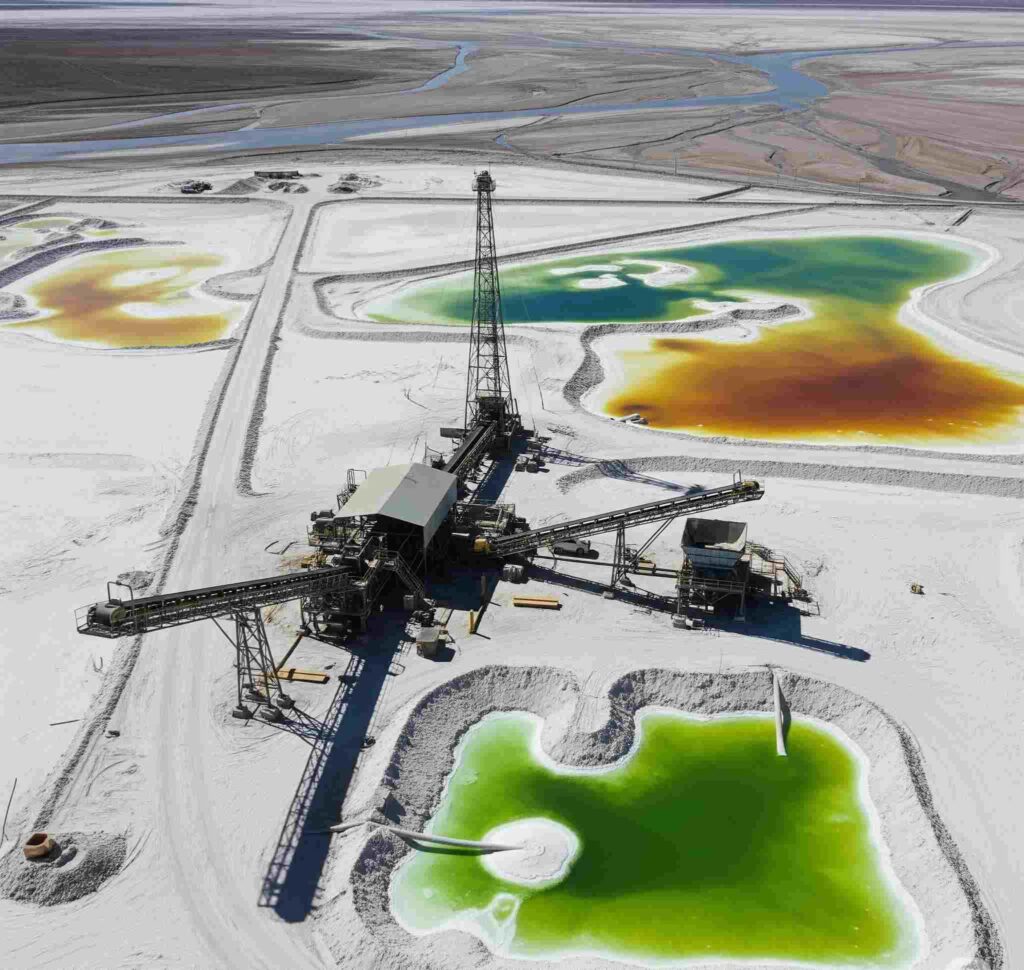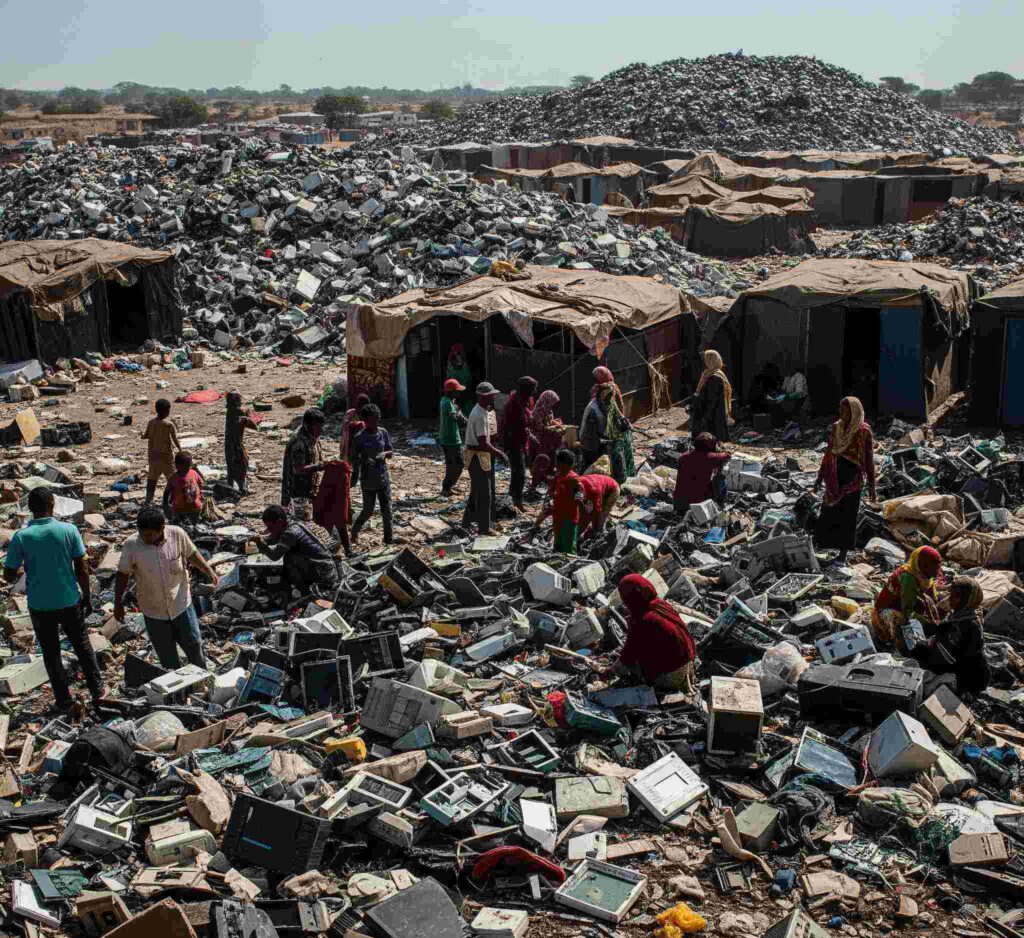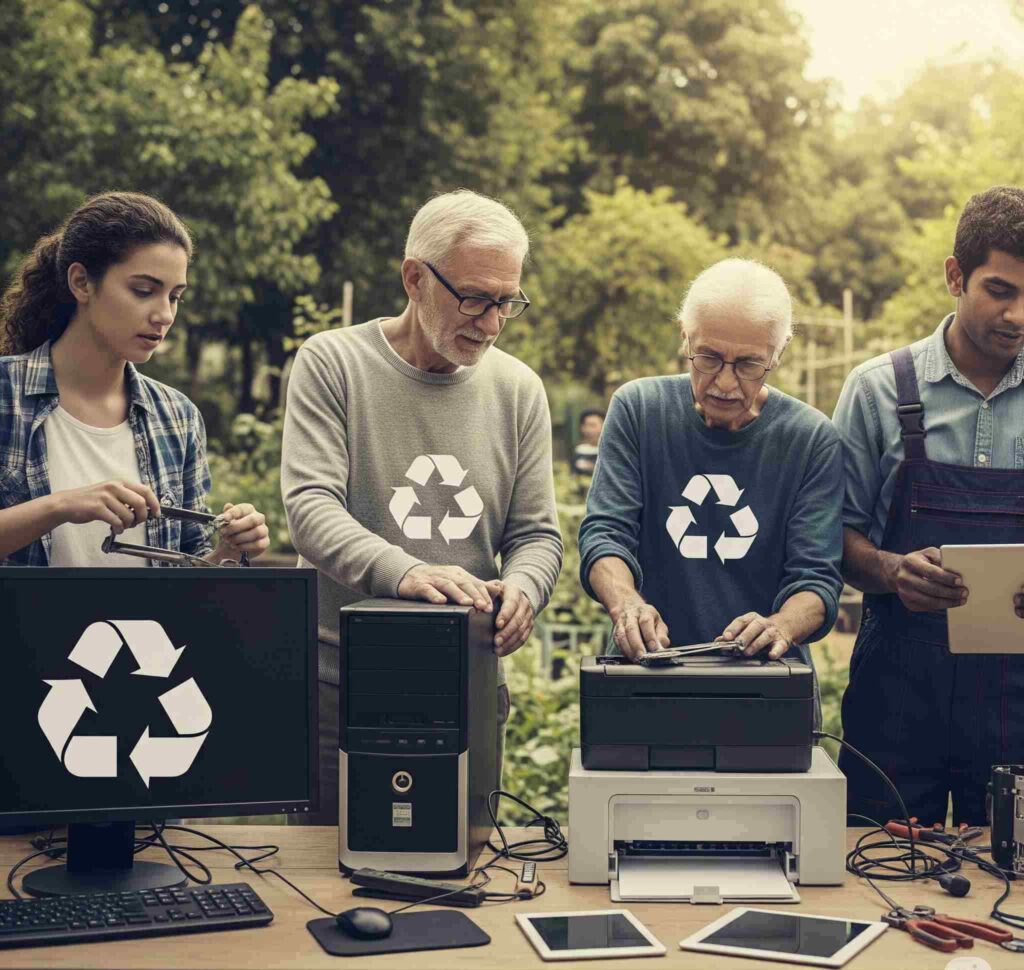
1. The Lithium Boom: A Double-Edged Sword
The Miracle Metal That Powers Our World
Lithium is the silent powerhouse behind every smartphone, laptop, and electric vehicle (EV). Touted as the “green oil” of the 21st century, it’s the key ingredient in the batteries that fuel our renewable energy dreams. Governments and corporations have invested billions into lithium mining, promising a future free from fossil fuels.
But here’s the brutal reality they don’t advertise: Lithium isn’t as clean as they claim.
The Environmental Cost of Lithium Mining
To extract lithium, miners pump billions of gallons of water into underground salt flats, draining already-scarce water supplies in arid regions like Chile’s Atacama Desert. The process leaves behind toxic brine ponds laced with heavy metals, poisoning the land for decades.
- Water Depletion: In Argentina’s Salar de Hombre Muerto, lithium mining consumes 65% of the region’s water, forcing local farmers to abandon their land.
- Chemical Contamination: The evaporation process releases chlorine, sulfuric acid, and other toxins into the soil, making it unusable for agriculture.
- Wildlife Destruction: Flamingos and other species in Chile’s Atacama are dying off as their habitats are destroyed.
The Hypocrisy of “Clean” Energy
EV manufacturers boast about zero emissions, but they ignore the environmental carnage caused by lithium mining. The truth? There’s no such thing as a truly “green” battery—at least, not yet.
The Coming E-Wave of Dead Batteries
The real crisis hasn’t even hit yet. By 2030, over 11 million tons of lithium-ion batteries will reach the end of their life. Right now, less than 5% are recycled properly. The rest? They’ll join the growing mountains of e-waste—leaking toxic chemicals into landfills or being shipped to developing nations.
Bottom line: The lithium revolution is built on a broken system—one that sacrifices people and the planet for profit.
2. What Happens When Your Phone Dies? The E-Waste Time Bomb
The Shocking Scale of Global E-Waste
Every year, the world generates 53 million metric tons of electronic waste—enough to cover Manhattan in junked gadgets. By 2030, that number will skyrocket to 74 million tons.
But here’s the kicker: Only 17% of e-waste is properly recycled. The rest? It’s either:
- Dumped in landfills, where toxic metals seep into groundwater.
- Shipped illegally to developing countries, where workers dismantle it by hand.
The Afterlife of Your Smartphone
Let’s follow the journey of an old iPhone:
- You Trade It In: Feeling eco-conscious, you send it to a “recycling program.”
- The Bait-and-Switch: Instead of being recycled, it’s sold to a broker who ships it to Ghana, Nigeria, or India.
- The Toxic Graveyard: In slums like Agbogbloshie, workers—many of them children—burn the plastic casing to extract copper, inhaling lead, mercury, and cadmium.
Why “Recycling” Is Often a Lie
Many corporate take-back programs are greenwashing scams. Investigations have found that:
- Amazon’s “recycled” electronics were dumped in developing nations.
- Apple’s “Daisy” recycling robot only handles a tiny fraction of its e-waste.
- Most “recyclers” are just middlemen who sell e-waste to the highest bidder.
The Human Cost of Our Tech Addiction
- Child Labor: In Ghana, kids as young as 10 smash open old TVs to collect copper wires.
- Cancer Clusters: Near e-waste dumps, miscarriage and cancer rates are 5x higher than normal.
- Poisoned Food: Heavy metals from e-waste seep into soil, contaminating crops.
Key Stat: A single CRT monitor contains 4-8 pounds of lead—enough to poison an entire family.
3. The Dirty Secret: Where Your “Recycled” Electronics Really Go
Welcome to Agbogbloshie: The Hellscape of E-Waste
In Accra, Ghana, lies Agbogbloshie—one of the largest e-waste dumps on Earth. Locals call it “Sodom and Gomorrah” for good reason:
- Rivers of molten plastic burn 24/7, filling the air with black, toxic smoke.
- Workers smash open batteries with rocks, exposing themselves to acid burns and heavy metal poisoning.
- The ground is so saturated with lead and mercury that nothing grows for miles.
How Tech Giants Outsource Their Pollution
Big Tech loves to virtue-signal about sustainability, but their actions tell a different story:
- Apple’s “100% recycled” claims? Only apply to a handful of components.
- Samsung’s “eco-friendly” phones? Still end up in illegal dumps.
- Tesla’s “green” batteries? No real plan for millions of dead EV batteries.
The Shady Middlemen of E-Waste
Most “recyclers” are just brokers who:
- Buy e-waste from Western countries.
- Label it as “used goods” to bypass laws.
- Sell it to informal scrapyards in poor nations.
Investigations have found:
- 80% of U.S. “recycled” electronics are exported illegally.
- Bribed customs officials look the other way as containers of toxic waste enter ports.
The Legal Loopholes That Keep This Going
- The Basel Convention bans hazardous waste exports—but the U.S. never ratified it.
- “Donation” scams: Companies label e-waste as “charity electronics” to avoid scrutiny.
The Hard Truth: Your old laptop doesn’t get a second life. It gets a slow, toxic death in a developing country.

4. Health & Environmental Catastrophe: The Human Cost of Cheap Tech
A Slow-Motion Poisoning of the Poor
Walk through the e-waste slums of Lagos or Dhaka, and you’ll see the same horrific scene everywhere: children covered in chemical burns, breathing air thick with the stench of melting circuit boards. This isn’t just pollution – it’s industrial-scale poisoning disguised as “recycling.”
The Invisible Killers in Your Old Gadgets
Every discarded smartphone is a cocktail of deadly substances:
- Lead – Causes permanent brain damage in children
- Mercury – Destroys kidneys and nervous systems
- Cadmium – Linked to lung and prostate cancer
- Brominated flame retardants – Disrupt hormones and fertility
In Ghana’s Agbogbloshie dump, medical tests show:
✔️ 72% of workers have dangerous lead levels
✔️ 60% suffer chronic respiratory diseases
✔️ Life expectancy is 20 years lower than national average
When the Land Itself Turns Toxic
The environmental damage is even more terrifying:
- Rivers run rainbow colors from heavy metal leakage
- Soil becomes sterile – unable to grow crops for generations
- Underground water sources are permanently contaminated
Near China’s former e-waste processing hub in Guiyu:
⚠️ Miscarriage rates are 6x higher than normal
⚠️ 80% of children test positive for lead poisoning
⚠️ Cancer clusters appear around dumping sites
The Human Faces Behind the Statistics
Meet 14-year-old Kwame, who spends 12 hours daily burning wires to extract copper. His cough never stops, his hands are covered in sores, and he earns $2 per day.
Or Maria, a mother in Manila, whose breast milk contains 40x the safe limit of brominated flame retardants because she lives near an e-waste site. This isn’t collateral damage – it’s corporate murder by neglect.
5. Who’s Profiting? The Hypocrisy of Big Tech & Greenwashing
The Great Tech Sustainability Lie
While Smartphonne companies brags about recycling to “save the environment,” they’ve:
➡️ Fought right-to-repair laws in 28 states in the US
➡️ Designed products to fail (planned obsolescence)
➡️ Refused to disclose their actual recycling rates
Follow the Money Trail
The real winners of the e-waste crisis:
- Tech Giants – Save billions by avoiding proper recycling
- Brokers – Make $500M/year shipping waste to Africa/Asia
- Mining Companies – Profit from constant demand for new materials
Greenwashing Exposed
Tesla’s Dirty Secret: Their “eco-friendly” cars:
☢️ Require 500,000 lbs of mined materials per GWh battery
☢️ Have no real solution for dead battery disposal
☢️ Source lithium from water-depleting mines in Chile
Microsoft’s “Carbon Negative” Claim: While they:
✖ Use single-use plastics in packaging
✖ Don’t track where 90% of their e-waste ends up
The Recycling Theater
Most corporate sustainability programs are PR stunts:
- Best Buy’s recycling – Sells waste to questionable brokers
- Dell’s “closed loop” – Only 10% of materials actually reused
- Amazon’s “Climate Pledge” – While increasing packaging waste
The ugly truth? It’s cheaper to poison poor countries than to reform.
6. Can This Be Fixed? Real Solutions vs. Empty Promises
What SHOULD Be Done (But Isn’t)
- Make Tech Last Longer
- Mandate 10-year software support
- Enforce right-to-repair laws globally
- Ban planned obsolescence practices
- True Producer Responsibility
- Force companies to take back every product they sell
- Implement heavy fines for illegal e-waste exports
- Fund proper recycling infrastructure in developing nations
- Cleaner Battery Alternatives
- Invest in solid-state batteries (less toxic)
- Develop sodium-ion alternatives to lithium
- Create standardized, replaceable battery modules
What ACTUALLY Works Today
✅ Fairphone– Modular, repairable phones with ethical sourcing
✅ Framework Laptop – Fully upgradable, 10+ year lifespan
✅ European Union – Leading with strict e-waste laws and recycling targets
What YOU Can Do Right Now
- Use Devices Longer – Resist upgrade culture
- Repair, Don’t Replace – Use sites likeiFixit
- Demand Accountability – Pressure lawmakers and corporations
- Recycle Properly – Only through e-Stewards or R2 certified handlers
The Cold Hard Reality
The solutions exist. The technology exists. What’s missing? Corporate willingness and political courage. Until we force change, the lithium revolution will keep sacrificing the global poor for our convenience.
Final Question: When you look at your phone tomorrow, will you see a tool – or a future piece of toxic waste poisoning a child halfway across the world?
. The Final Wake-Up Call: What You Can Do Right Now
This Isn’t Someone Else’s Problem – It’s Yours
You’ve just read how the lithium revolution is poisoning the planet and exploiting the poor. Now comes the hard question: What are you going to do about it?
This isn’t about guilt—it’s about power. Because every time you buy, discard, or demand change, you’re either fueling the crisis or fighting it.
7. Immediate Actions That Actually Matter
1. Stop Upgrading Like a Mindless Consumer
- Keep your phone for 4+ years (The average upgrade cycle is 2.3 years—that’s insanity.)
- Buy refurbished instead of new (Companies like Back Market sell like-new devices at half the price.)
- Repair, don’t replace (iFixit has guides for fixing almost any gadget.)
2. Demand Right-to-Repair Laws
- Tech giants lobby against repair freedom because they want you trapped in upgrade cycles.
- Support organizations like Repair.org pushing for legislation.
- Tweet at Apple/Samsung—public pressure works.
3. Recycle Properly – Not Through Corporate Greenwashing
- Most “recycling” programs are scams. Use e-Stewards or R2-certified recyclers only.
- Never toss electronics in the trash—those toxins will seep into groundwater.
- Batteries are especially dangerous—find a local hazardous waste drop-off.
4. Boycott the Worst Offenders
- Smartphone Corporations (Fights right-to-repair, uses disposable designs)
- EVs Corporations (No real battery recycling plan)
- Giant Ecommerce Stores (Floods the market with cheap, unrepairable gadgets)
5. Spread the Word – Make This a Movement
- Share this article (Most people have no idea where their e-waste goes.)
- Talk to friends & family about holding onto devices longer.
- Pressure politicians to ban e-waste exports and mandate recycling.
The Choice Is Yours
You can keep pretending this isn’t your problem—or you can take action today.
Because if not you, who? If not now, when?

8. FAQs: The Lithium & E-Waste Crisis Explained
Q1: Is lithium mining worse than fossil fuel drilling?
A: In some ways, yes.
- Fossil fuels pollute the air; lithium mining destroys water supplies.
- A single EV battery requires 500,000 gallons of water to extract enough lithium.
- Unlike oil, lithium can’t be replaced once contaminated water is gone.
Q2: Can lithium batteries actually be recycled?
A: Barely.
- Current methods recover only 50% of materials.
- The process is expensive and energy-intensive—most companies won’t pay for it.
- Tesla’s “recycling” program is still in early stages and not scalable yet.
Q3: Where does most of the world’s e-waste go?
A: Developing nations—illegally.
- Ghana (Agbogbloshie)
- Nigeria (Lagos scrapyards)
- India (Delhi’s Seelampur)
- Pakistan (Karachi’s ship-breaking yards)
Q4: What’s the most dangerous item in e-waste?
A: CRT monitors (old TVs & computers).
- Each contains 4-8 lbs of lead—enough to poison an entire family.
- When smashed open, lead dust contaminates soil for decades.
Q5: Are any tech companies doing this right?
A: A few are trying:
- Fairphone (Modular, repairable phones)
- Framework (Upgradable laptops)
- Dell (limited) – Uses some recycled plastics
Q6: What’s the #1 thing I can do today?
A: Stop buying new gadgets unnecessarily.
- Use your phone until it dies.
- Repair instead of replace.
- Demand better from corporations.
Final Thought
This crisis won’t be fixed by hoping for change. It’ll be fixed when enough people refuse to accept the status quo.
Will you be one of them?
Want More?
- Share this article to wake others up& Subscribe to our push notifications.
- Check out The Basel Action Network for e-waste activism.
- Comment below with your own actions against e-waste.
The power to change this starts with YOU.
